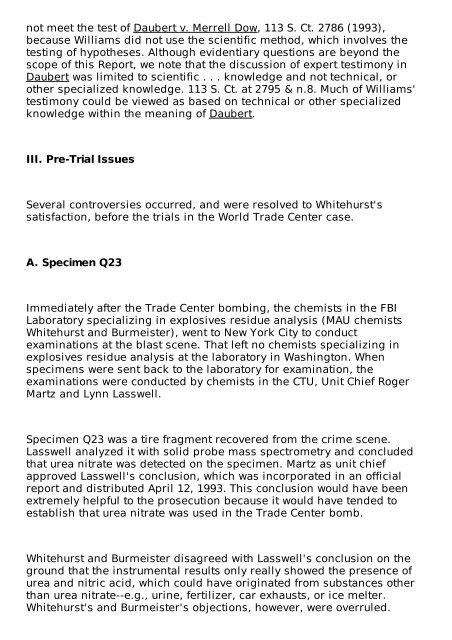linked - Investigating the Terror
linked - Investigating the Terror
linked - Investigating the Terror
You also want an ePaper? Increase the reach of your titles
YUMPU automatically turns print PDFs into web optimized ePapers that Google loves.
not meet <strong>the</strong> test of Daubert v. Merrell Dow, 113 S. Ct. 2786 (1993),<br />
because Williams did not use <strong>the</strong> scientific method, which involves <strong>the</strong><br />
testing of hypo<strong>the</strong>ses. Although evidentiary questions are beyond <strong>the</strong><br />
scope of this Report, we note that <strong>the</strong> discussion of expert testimony in<br />
Daubert was limited to scientific . . . knowledge and not technical, or<br />
o<strong>the</strong>r specialized knowledge. 113 S. Ct. at 2795 & n.8. Much of Williams'<br />
testimony could be viewed as based on technical or o<strong>the</strong>r specialized<br />
knowledge within <strong>the</strong> meaning of Daubert.<br />
III. Pre-Trial Issues<br />
Several controversies occurred, and were resolved to Whitehurst's<br />
satisfaction, before <strong>the</strong> trials in <strong>the</strong> World Trade Center case.<br />
A. Specimen Q23<br />
Immediately after <strong>the</strong> Trade Center bombing, <strong>the</strong> chemists in <strong>the</strong> FBI<br />
Laboratory specializing in explosives residue analysis (MAU chemists<br />
Whitehurst and Burmeister), went to New York City to conduct<br />
examinations at <strong>the</strong> blast scene. That left no chemists specializing in<br />
explosives residue analysis at <strong>the</strong> laboratory in Washington. When<br />
specimens were sent back to <strong>the</strong> laboratory for examination, <strong>the</strong><br />
examinations were conducted by chemists in <strong>the</strong> CTU, Unit Chief Roger<br />
Martz and Lynn Lasswell.<br />
Specimen Q23 was a tire fragment recovered from <strong>the</strong> crime scene.<br />
Lasswell analyzed it with solid probe mass spectrometry and concluded<br />
that urea nitrate was detected on <strong>the</strong> specimen. Martz as unit chief<br />
approved Lasswell's conclusion, which was incorporated in an official<br />
report and distributed April 12, 1993. This conclusion would have been<br />
extremely helpful to <strong>the</strong> prosecution because it would have tended to<br />
establish that urea nitrate was used in <strong>the</strong> Trade Center bomb.<br />
Whitehurst and Burmeister disagreed with Lasswell's conclusion on <strong>the</strong><br />
ground that <strong>the</strong> instrumental results only really showed <strong>the</strong> presence of<br />
urea and nitric acid, which could have originated from substances o<strong>the</strong>r<br />
than urea nitrate--e.g., urine, fertilizer, car exhausts, or ice melter.<br />
Whitehurst's and Burmeister's objections, however, were overruled.


